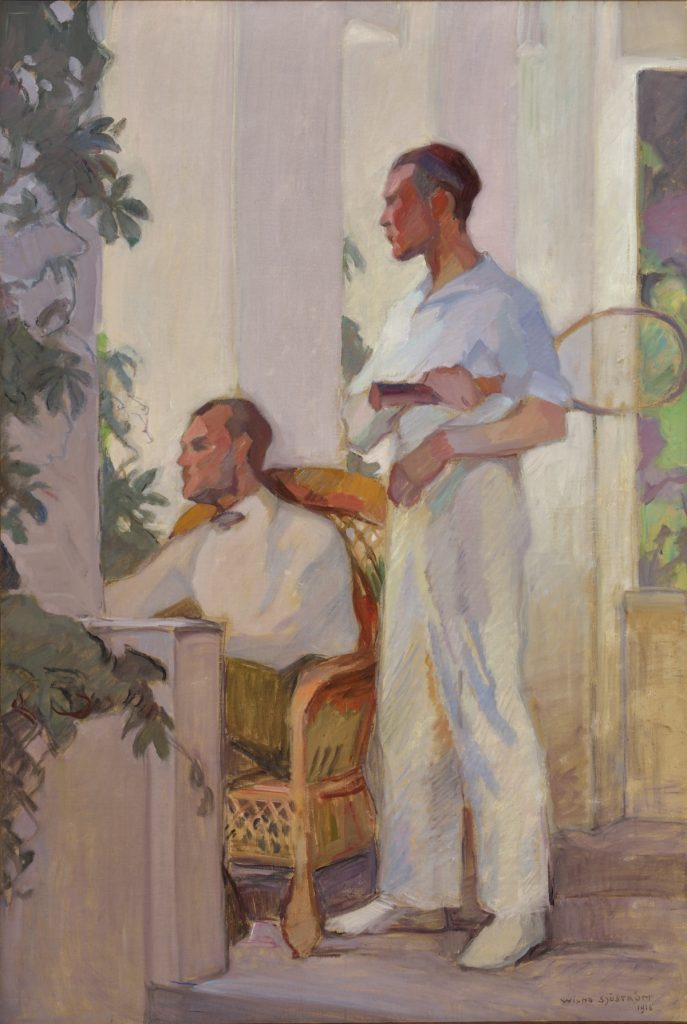Wilho Sjöström: Tennis Players
SEPTEMBER 2024
Painted in 1916, Tennis Players is a work created during Wilho Sjöstöm’s transitional period both from the perspective of his art as well as his personal life. The piece is enigmatic, and a good example of to how many details the interpretation of an artwork may extend.
Around the year 1910, Wilho Sjöström threw himself into Neo-Impressionistic colour change which was referred to as era of pure palette. Towards the end of the year in Kulosaari villa town, a studio designed by Armas Lindgren was completed and Sjöström settled there along with his artist-spouse Tyra Malmström. During the next years, inspired by Neo-Impressionist colour theories, white house art in pure palette was rendered with eloquent brushstrokes.
On the brink of the first world war, the pace of the ephemeral moments started to slow down after his trip to England and France. Paragons in the Les Nabis group, classic forms and decorative texture started to interest the artist ever more. They were useful indeed, when the artist concentrated more intensively into portrait commissions which eased at times the villa owner’s debt worries.
He also succeeded in competition for monumental works. The altar piece in Pukkila depicting The Sermon on the Mount was completed in 1915, and the next year the fresco in the Art Nouveau style hall of Privatbanken presenting Helsinki landscape silhouette.
In summer 1916 Sjöström was occupied by the sketches he made for Privatbanken’s fresco, but alongside them, he created other works. Paintings in which summer light merged with free painterlines were created on the deck at the white house. The flightyness of the brush is tamed at times to parallel brushstrokes and the forms settle down into careful cubist facets.
On the deck he portrayed the Privatbanken’s bank manager Emil Schybergson as well the tennis players. The bank manager who lived next door, had athletic sons, Lars, Ernst, and Richard. It is natural to look for models among them. During the time of the creation of the painting, Ernst published Finland’s first tennis books and participated in the tennis tournament at the 1924 Paris Olympic Games.
One historical sport event also is connected to the time of the creation of the painting. From the deck of the white house, one could have a visual contact to Kulosaari tennis court where the second national championships were organized in late July. During the first day of the tournament, it was raining and they could play hardly any matches that day.
The stylish restlessness of the characters is well explained with waiting for the rain to stop. Ernst and his partner C. V. Sandelin participated in the doubles but had no success this time. The painting most likely has a connection to this tennis tournament, but it is not a document of the event. In fact, the features of the characters do not at all match those of Schybergson and Sandelin.
A sketch for the work which has remained in the possession of the artists family offers an alternative interpretation. According to generic knowledge, the characters in the piece are young lawyers and later cabinet ministers Ernst von Born and Hjalmar Procopé. Their interest in tennis hobby has not been recorded, but they obviously have given their noble features to the tennis players waiting for fine weather.
The violet toned melancholy of the Tennis Players temps to interpret also the painting as mental representation of the artist himself. The light years of the white house are long gone as the marriage of the artist couple had drifted to the point of decline. Wilho Sjöström had reacquainted himself with his crush from the turn of the century, dentist Vieno Kalima, the daughter of the chaplain in Viitasaari.
Without much drama, the artist couple broke up, and Wilho engaged himself into a new marriage. The Studio in Kulosaari was sold, and a new era in artist’s life began. Personal happiness and the future of the independent Finland was shadowed by a troubled time which eventually grew darker in the time of the civil war.
Bright colours of Kulosaari were changed into dark and brooding landscapes of Viitasaari, which only gradually revived reminding of the artist’s past as a renderer of fleeting moments of colour and light.
Heikki Hanka
Professor of Art History


